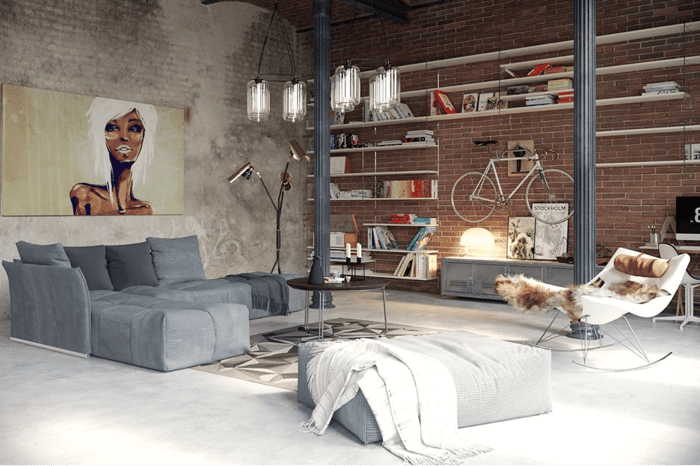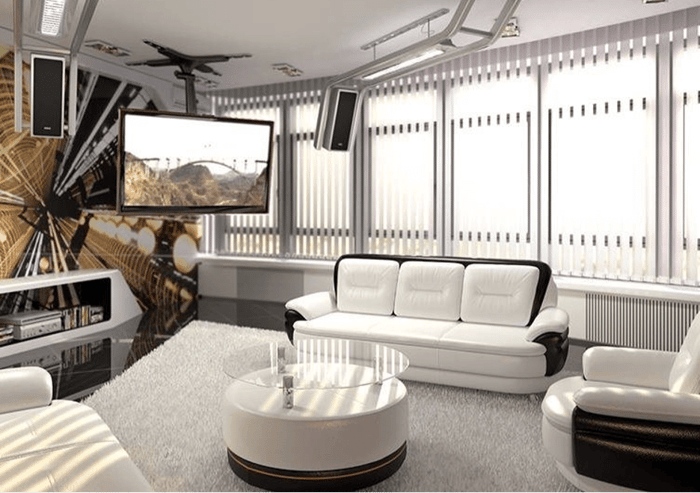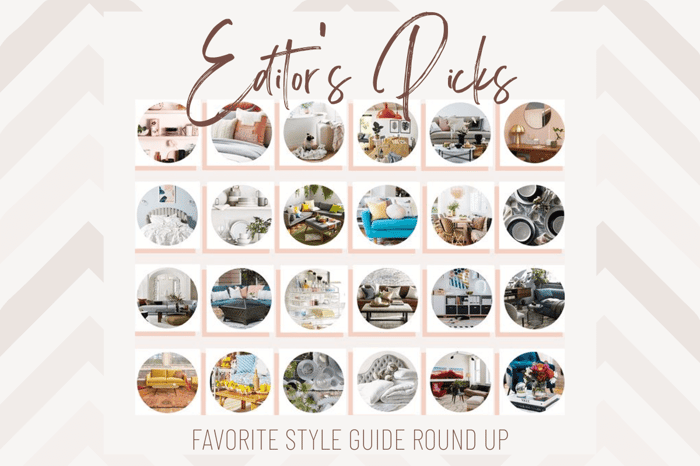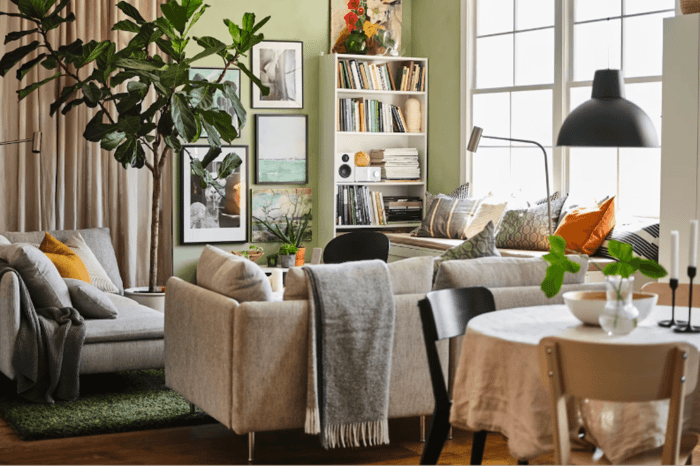It’s the yin-yang of home decorating. A balancing act between masculine and feminine. A merging of engineered exposed steel and organic, raw materials. The foundation of industrial decor is harnessed in the grit of utilitarian spaces, transforming factories and warehouses into simultaneously bold yet refined spaces.
Industrial Style Defined
This rough and raw decor style was born from the forgotten lofts, warehouses, and abandoned factories in larger cities. It was a way of looking at the old and worn-out with fresh eyes; turning leftovers and salvaged materials into creative furnishings. Industrial style is really the mother of sustainable and eco-conscious living where nothing goes to waste and creative ways to upcycle are at the heart of the movement.
 Additional key elements:
Additional key elements:
- Tough & utilitarian furnishings: sturdy, heavy-duty materials such as solid wood, steel, & iron. Functional versus luxurious furnishings.
- Raw materials: weathered, unfinished surfaces; exposed brick, cinder block, wooden beams, concrete floors, steel windows, and visible ductwork.
- Salvaged: creating new out of leftover materials; from converting a warehouse to building tables from pallets.
- Durable & simple: look for pieces that can withstand heavy use.
While all that may sound slightly harsh, the goal is to achieve an aesthetic balance. There is beauty to be found in open spaces and the natural integrity that is always found in raw, organic materials. Don’t have an old textile factory on hand? No worries. This style can also be produced through using specific finishes and stylized decor pieces. Read on for some inspirational ideas and industrial advice.
 Industrial Style Plus: Before Beginning
Industrial Style Plus: Before Beginning
As mentioned in other Style Guides, it is prudent to have a game plan before undertaking your interior design project. If Industrial is your main objective go for it; this guide will give you a comprehensive outline to follow. But a reminder. Nothing is set in stone, there are no hard and fast rules when it comes to developing your personal style guide. Never hesitate to add in different schools of design. For example, you can include elements of mid-century modern or farmhouse chic in your overall plan. Your industrial design might take a more modern edge rather than full-on rugged steampunk.
THE SPACE
The history of industrial style decor comes from large open spaces of sizable warehouses, lofts, and old factories. Taking advantage of ‘space’ is key for this design to manifest. Walls are more bare than not, highlighting large artist pieces, grand mirrors or sculptures. Organized work spaces, open seating, and attention to light and texture play a pronounced role as well. Plan for clean lines, taking advantage of negative space to get the most impact from the existing foundational elements of the room.
 COLOR
COLOR
First take into account what’s initially present in the space, whether it is concrete flooring, brick or cinder block walls, exposed wooden beams, metallic vents or piping. Then make the next decision about what color palette to use for the remaining areas, furniture, and accents. Assuming that furnishings will most likely be constructed of metals, leather, raw and reclaimed wood, you can take those hues of browns and grays into account when deciding on additional colors. Contrasting elements can be inserted with accents, rugs, and other details.
The star of the show in an industrial space is the architecture, the structure and the bones of the building itself; meaning don’t let bright colors steal the scene. Best to keep any color pops to a single bold statement in the form of a piece of artwork, a bold accessory, or an accent wall. Paint colors for industrial decor:
- Neutrals- espresso, sand, slate.
- Matte black and stark white.
- Accent color: teal, bright red, royal blue, chartreuse.
 FLOORING
FLOORING
The industrial setting is rugged. If the floor is concrete, you are off to a good start. This works perfectly as the foundation of an industrial-style space. Add a distressed or neutral solid-colored rug to finish. Rug tones in deep red, grey, darker blues, or burnt oranges fall in the range of earthy hues that are reflecting back the metals used in industrial construction: iron, rusted metal, steel. If you prefer a floor covering with some design, most ethnic patterns will work as long as they are faded, not too vivid or bright in color. Layering a few rugs will insert some texture and a more dynamic effect to the room.

FURNITURE
Stripped, simple, raw. Industrial furniture places emphasis on structure and highlights imperfections. Common materials include steel, iron, aluminum, and reclaimed wood. Imperfect finishes and chipped edges are welcome. Old furnishings from class rooms, locker rooms, construction site work tables, steel stools will fit into an industrial decor setting perfectly. Pieces that combine wood and metal are ideal examples as well.
Wood furniture in the industrial style combines metalwork, raw wood, and distressed, vintage, and upcycled materials. The natural beauty that gets exposed over time with the wear and tear of use exudes a certain glow or patina that is difficult to manufacture.
 Reinforced concrete is a trending industrial style that makes a striking statement.
Reinforced concrete is a trending industrial style that makes a striking statement.
 Tufted seats lined with nail heads is a more traditional industrial choice. A vintage styled chesterfield sofa with antique nail heads, wrapped in a distressed faux leather, and metal finished feet is a classic.
Tufted seats lined with nail heads is a more traditional industrial choice. A vintage styled chesterfield sofa with antique nail heads, wrapped in a distressed faux leather, and metal finished feet is a classic.
 Linen upholstered sofas and chairs are a suitable option if you’re not into the leather look.
Linen upholstered sofas and chairs are a suitable option if you’re not into the leather look.

LIGHTING
Industrial decor lighting comes in two distinct options: either modern or vintage.
 A more rustic, vintage vibe seems to be a classic industrial style addition in lighting options. There are so many different choices to go after in this category. Patinated finished lighting from almost every decade can be found in second hand stores across the nation. A single statement piece or a series of hanging dimmer bulbs both fit into this decor. Steampunk pieces reminiscent of eras gone-by with their intricate mechanical components are a popular option in industrial lighting.
A more rustic, vintage vibe seems to be a classic industrial style addition in lighting options. There are so many different choices to go after in this category. Patinated finished lighting from almost every decade can be found in second hand stores across the nation. A single statement piece or a series of hanging dimmer bulbs both fit into this decor. Steampunk pieces reminiscent of eras gone-by with their intricate mechanical components are a popular option in industrial lighting.
 ACCENTS
ACCENTS
Piping
Piping in an industrial style home looks to repurpose these elements into new design accents. All sorts of furnishings can be made from piping: shelving units, light fixtures, artistic pieces, hanging racks, etc.
 Salvaged
Salvaged
Found objects and repurposed items are at the core of industrial decor. Using them in the accents of your home is an ideal way to showcase your individual style and add some softer elements to balance out all the rough and raw textures that hold the space.
 Salvaged objects, usually inspired by machine parts, add authentic vintage appeal to industrial interiors. This part of the decorating process is an important way to express your creativity. Adding colorful pieces with an artistic flair is a finishing touch that provides an element of warmth and glow to balance out the heavy steel and concrete structures.
Salvaged objects, usually inspired by machine parts, add authentic vintage appeal to industrial interiors. This part of the decorating process is an important way to express your creativity. Adding colorful pieces with an artistic flair is a finishing touch that provides an element of warmth and glow to balance out the heavy steel and concrete structures.
 Outline For An Industrial Kitchen
Outline For An Industrial Kitchen
Sleek metal, durable restaurant style surfaces and appliances set the tone for an industrial designed kitchen. Matte painted finishes and wood elements are additional options.
Features:
- Concrete or steel counters.
- Exposed pipes, electrical conduits, bolts and brackets as design features.
- Open shelving.
- Raw materials.
- Reclaimed wood.
- Simple hardware.
- Stainless steel appliances, cabinets, islands and carts.
- Sturdy appliances in durable finishes.
 Outline For An Industrial Bathroom
Outline For An Industrial Bathroom
The raw, tough, hardworking theme of industrial kitchens can continue into the bathroom setting as well.
Features:
- Glass and metal showers.
- Hardware in mechanical styles.
- Minimal accessories.
- Reclaimed wood frames, shelves, or side tables.
- Vanity made from metal elements.
- White tile with dark grout.
 SUMMARY
SUMMARY
All the components needed to build your Industrial Style home are already in existence. If mining vintage and consignment stores, estate and yard sales, as well as your local flea markets makes your heart happy, industrial style may be in the cards for you. This is also an excellent decor style to save on cost as well as maintaining an environmentally conscious lifestyle by choosing to purchase gently used products versus new. Train your eye to find beauty in the obscure, rethinking how to use materials and well as open spaces and your industrial decorated home will emerge in no time.
#industrialdesign #design #productdesign #interiordesign #industrial #interior #architecture #homedecor #designer #d #dise #art #furniture #vintage #furnituredesign #designinspiration #render #handmade #home #industrialdecor #engineering #o #keyshot #rendering #product #decor #cardesign #wood #salvaged #reclaimed #vintage #rusticdecor #salvage #handmade #rustic #woodworking #salvagedwood #repurposed #reclaimedwood #recycle #vintagehome #furniture #upcycle #farmhouse #woodwork #antiques #recycled #antique #upcycled #custom #barnwood #art #patina #woodworker








